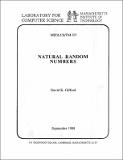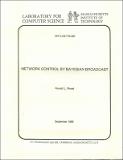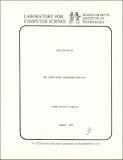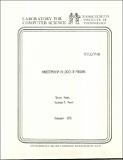Browsing LCS Technical Memos (1974 - 2003) by Title
Now showing items 281-300 of 492
-
NAIVE - Network Aware Internet Video Encoding
(1999-04)The distribution of digital video content over computer networks has become commonplace. Unfortunately, most digital video encoding standards do not degrade gracefully in the face of packet losses, which often occur in a ... -
Naming and Directory Issues in Message Transfer Systems
(1984-07)A message transfer system requires some means for users to determine the addresses of their correspondents. A Directory Service aids users in identifying a particular correspondent and the correspondent's address. In this ... -
Natural Random Numbers
(1988-09)We present a method for generaing random numbers from natural noise sources that is able to produce random numbers to any desired level of perfection. The method works by transducing a physical noise source to generate a ... -
A Near-optimal Method for Reasoning About Action
(1978-09)We give an algorithm for "before-after" reasoning about action. The algorithm decides satisfiability and validity of formulae of propositional dynamic logic, a recently developed logic of change of state that subsumes the ... -
Network Control by Bayesian Broadcast
(1985-09) -
A Network Traffic Generator for Decent
(1979-03)Computer network traffic generators provide a means for supplying benchmark results and for measuring computer network performance at all levels. Eventually they will also aid in fault diagnosis. The network traffic generator ... -
A New Fault-tolerant Algorithm for Clock Sychronization
(1984-07)We describe a new fault-tolerant algorithm for solving a variant of Lamport's clock synchronization problem. The algorithm is designed for a system of distributed processes that communicate by sending messages. Each process ... -
A New List-tracing Algorithm
(1970-10)List-processing systems have each allowed use of only a single size and configuration of list cell. This paper describes a system which allows use of arbitrarily many different sizes and configurations of list cell, ... -
New Lower Bound Techniques For VLSI
(1982-08)In this paper, we use crossing number and wire area arguments to find lower bounds on the layout area and maximum edge length of a variety of new and computationally useful networks. In particular, we describe 1) an N-node ... -
A New Max-flow Algorithm
(1985-11)All previously known max-flow algorithms worked by finding augmenting paths, either one path at a time (Ford and Fulkerson algorithm), or all shortest augmenting paths at once (by using the level network technique of Dinic). ... -
A New Self-Play Experiment in Computer Chess
(2000-05)This paper presents the results of a new self-play experiment in computer chess. It is the _x000C_rst such experiment ever to feature search depths beyond 9 plies and thousands of games for every single match. Overall, we ... -
Nnuclear Fusion Through Dimensional Confinement
(1989-08)A formal mechanism for enhancing nnuclear fusion rates is proposed. The enhancement results whenever the reacting nuclei preferentially migrate in a restricted subspace of phase space - in particular, a fractal subspace. ... -
Non-ontrusive Synchonizers
(1990-04) -
Nondeterminism in Logics of Programs
(1978-02)We investigate the principles underlying reasoning about nondeterministic programs, and present a logic to support this kind of reasoning. Our logic, an extension of dynamic logic ([22] and [12]), subsumes most existing ... -
Nonsequential Computation and Laws of Nature
(1986-05)Traditionally, computational complexity theory deals with sequential computations. In the computational models the underlying physics is hardly accounted for. This attitude has persisted in common models for parallel ... -
A Note on Equivalences Among Logics of Programs
(1981-12)Several different first order formal logics of programs -- Algoritmic Logic, Dynamic Logic, and Logic of Effective Definitions -- are compared and shown to be equivalent to a fragment of constructive L ω1ω. When programs ... -
A Note on the Stability Requirements of Adaptive Virtual Queue
(2002-02)Choosing the correct value for the parameters of an Active Queue Management (AQM) scheme is a well-known hard problem. The Adaptive Virtual Queue (AVQ) attempts at solving this problem by using stability requirements to ... -
Offline Authentication of Untrusted Storage
(2002-08)We extend the offline memory correctness checking scheme presented by Blum et. al [BEG+91], by using incremental cryptography, to detect attacks by an active adversary. We also introduce a hybrid o_ine-online checking ...



















